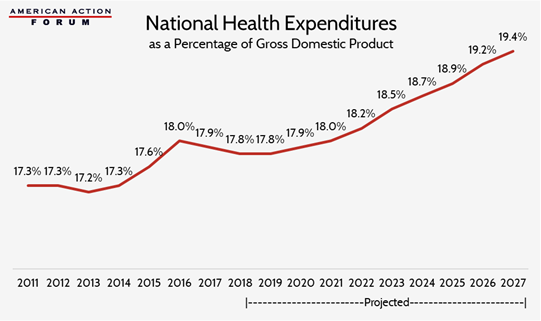Weekly Checkup
March 1, 2019
The Latest Medicare for All: Contradiction, Confusion, and Bet Hedging
Representative Pramila Jayapal led 106 other House Democrats this week in introducing a new and expanded version of Senator Bernie Sanders’s Medicare for All legislation. You already know the basics: Everyone gets everything for free because of the magic of government. That said, there are some nuggets worth commenting on.
For starters, when Sen. Sanders embarked on his single-payer crusade, he originally envisioned a process that would take four years for full implementation. That timeline was probably ambitious considering that the much narrower Affordable Care Act (ACA) also had a four-year implementation window, and we all know how that worked out. So House Democrats cut that timeline in half for remaking roughly 18 percent of the U.S. economy. Yes, the complete and total replacement of our entire health care system will take place exactly two years after enactment of this legislation. This timeline should be your first clue that this bill isn’t a serious proposal intended to become law, but rather a messaging document intended for political posturing.
The rest of the legislation alternates between sweeping promises and attempts to rebut obvious criticisms. The new government health insurance program will cover all medically necessary or appropriate services, but it will absolutely not cover items the Secretary of Health and Human Services (HHS) deems unnecessary—unless, of course, a qualified medical professional thinks the service should be provided to the patient, in which case covered benefit limitations be damned.
Like the Sanders bill, this legislation effectively ends all other forms of insurance, be they private or public—except for the Veterans and Indian Health Services, two programs desperately in need of improvement and reform, but which (one assumes) were too politically fraught to touch. And lest the sponsors be accused of ending private health insurance, they’re careful to prohibit only all currently available private health insurance. Americans could still buy private coverage that covered only items that are not covered by the entirely comprehensive benefit package prescribed in the law.
There will be no copays, deductibles, coinsurance, or premiums in this brave new world, and the new and improved Medicare will also cover long-term care services free of charge (something AAF President Douglas Holtz-Eakin wrote about in more detail on Wednesday). Additionally, at least 1 percent of federal Medicare for All spending in the early years will be diverted to jobs programs for all the people who will lose their careers within two years of enactment, a rare acknowledgment of the potentially catastrophic economic impact of such a sweeping proposal implemented so rapidly.
But how will this all be paid for? For starters, the proposal requires HHS to make a budget and to allocate all necessary funds, so there is that. Some funding will come from the current federal spending on health care programs that becomes obsolete, but those funds would barely begin to cover the spending being proposed.
The contradictory particulars of the proposal itself go on, but perhaps one of the more confusing takeaways politically is that 18 of Rep. Jayapal’s cosponsors are also members of the New Democratic Coalition. This coalition of moderate Democrats counterprogrammed the Medicare for All bill’s release by calling on House committees of jurisdiction to focus on protecting and improving the ACA rather than pursuing single-payer. I guess that’s one way to hedge your bets.
Chart Review
Kate Dixon, Health Care Policy Intern
There is no question that health care costs for patients and the government are rising every year. Last week, the Centers for Medicare & Medicaid Services released the 2019 National Health Expenditures data, which includes historical spending estimates from 2011 through 2017 as well as projected spending from 2018 through 2027. The results show that U.S. expenditures on health care are expected to continue to grow as a percentage of GDP, reaching 19.4 percent by 2027, or $5.69 trillion.
Worth a Look
New York Times: F.D.A. Says Canadian Company, CanaRx, Sells Unsafe Medicines to U.S. Buyers
Health Affairs: Access To E-Prescriptions And Related Technologies Before And After Hurricanes Harvey, Irma, And Maria











